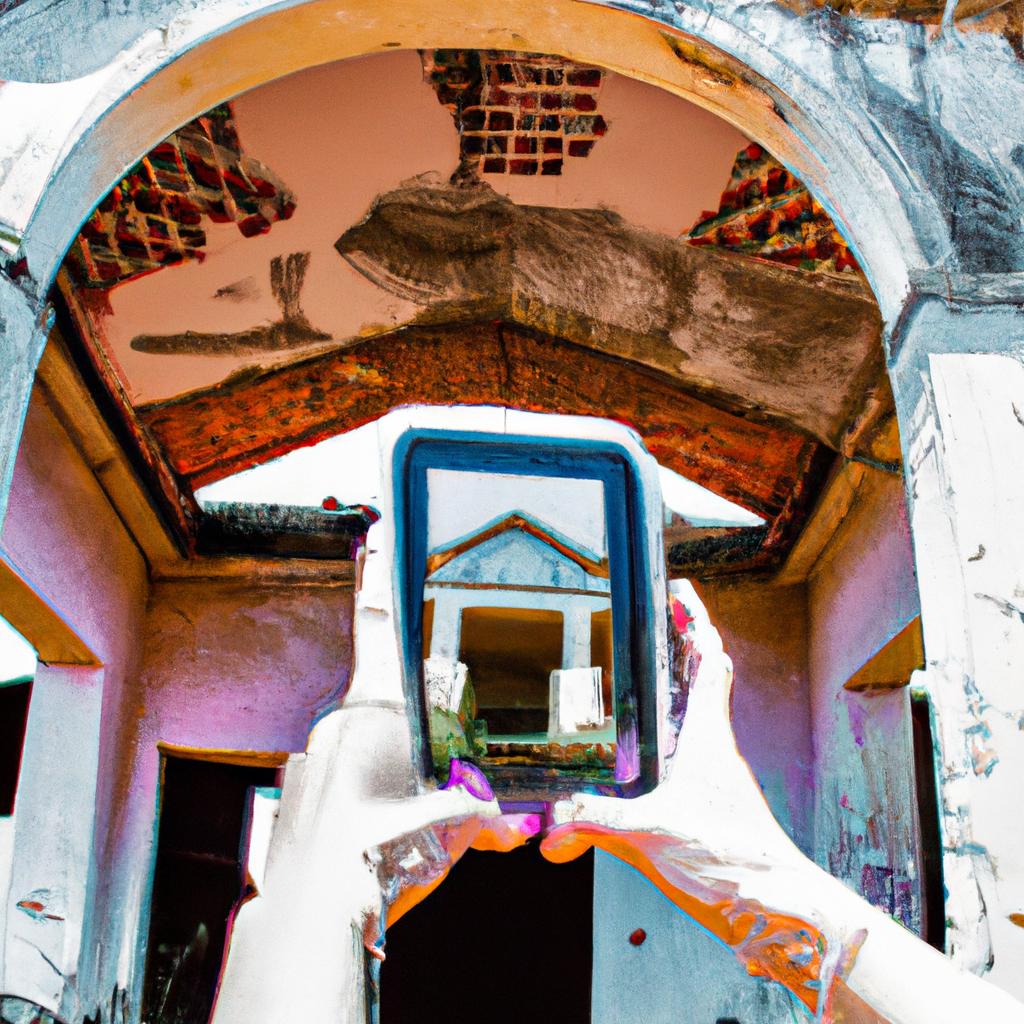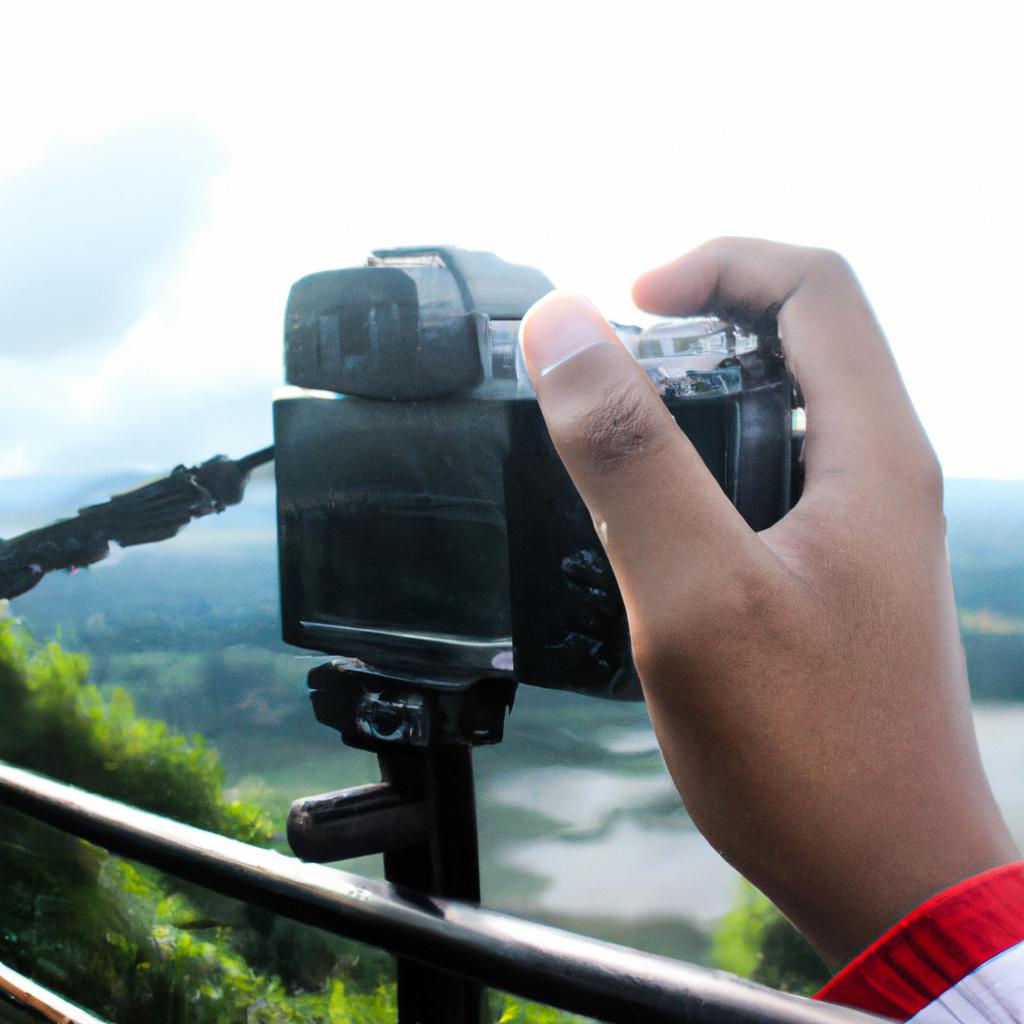Street photography is a genre of photography that captures everyday life in public spaces. It involves capturing candid moments and spontaneous scenes, often focusing on the interactions between people and their surroundings. The art of street photography lies in the ability to capture these fleeting moments, creating visually compelling images that tell stories about society and culture.
One example that exemplifies the essence of street photography is Henri Cartier-Bresson’s iconic photograph titled “Behind Gare Saint-Lazare.” In this image, Cartier-Bresson captured a man leaping over a puddle behind a train station, freezing a split-second moment filled with tension and anticipation. This photograph showcases not only Cartier-Bresson’s technical skills but also his keen eye for composition and timing. Through this single frame, he tells a story about the human experience within an urban environment.
The techniques employed in street photography are heavily influenced by other artistic disciplines such as painting and documentary photography. By studying the works of renowned painters like Edward Hopper or photographers like Diane Arbus, one can gain insights into how to use light, shadow, framing, and perspective to create powerful visual narratives. Furthermore, understanding the historical context in which street photography emerged allows artists to appreciate its significance as both an art form and as a form of social commentary. Street photography rose to prominence in the mid-20th century, coinciding with the rise of urbanization and the development of modern cities. Photographers like Cartier-Bresson, Robert Frank, and Garry Winogrand used street photography as a means to document and critique society during this transformative period.
To practice street photography effectively, it is important to develop a keen sense of observation and anticipation. Being able to anticipate interesting moments before they happen allows photographers to position themselves in the right place at the right time. Additionally, it is crucial to respect people’s privacy and capture candid moments without intruding or disrupting the scene.
In terms of equipment, many street photographers prefer using small, inconspicuous cameras that allow for quick and discreet shooting. This includes compact mirrorless cameras or even smartphone cameras that provide flexibility in capturing spontaneous moments while maintaining a low profile.
Lastly, when it comes to post-processing street photographs, it is essential to strike a balance between enhancing the image aesthetically while preserving its authenticity. Minimal adjustments such as cropping, adjusting exposure or contrast can be made to enhance the impact of the photograph without altering its fundamental nature.
Ultimately, street photography provides an opportunity for artists to explore and document the ever-changing world around us. By observing everyday life with curiosity and empathy, photographers can create compelling images that not only reflect society but also evoke emotions and spark conversations about our shared human experience.
Understanding the Essence of Street Photography
Imagine walking down a bustling city street, surrounded by people going about their daily lives. Suddenly, you come across a captivating image that freezes a moment in time—the laughter of children playing in a park, the intensity on a vendor’s face as they sell their goods, or the unexpected juxtaposition of elements that creates an intriguing visual narrative. This is the essence of street photography; capturing candid moments and fleeting emotions within public spaces.
To truly comprehend street photography, it is crucial to recognize its distinguishing characteristics. Firstly, street photographers typically work with minimal equipment, relying on compact cameras or even smartphones to capture scenes spontaneously without drawing attention. This discreet approach allows them to blend seamlessly into the environment and preserve authenticity. Secondly, unlike traditional studio portraiture where subjects are posed and directed, street photography captures unposed individuals in natural settings, showcasing genuine human experiences. Lastly, timing plays a vital role in this genre—a split second can make all the difference between capturing an ordinary scene and immortalizing something extraordinary.
The emotional impact of street photography lies not only in its ability to document reality but also in its capacity to evoke empathy and provoke thought. Through powerful imagery, these photographs enable viewers to connect with diverse narratives from around the world and gain insight into different cultures and perspectives. They offer glimpses into the beauty found in everyday life—moments we may often overlook or take for granted. In examining such images, one might experience awe at witnessing rare occurrences or find solace in shared human experiences.
Consider these examples:
- A photograph depicting an elderly couple holding hands tightly while navigating through crowded streets evokes feelings of love enduring against adversity.
- An image revealing vibrant colors amidst dilapidated buildings reminds us of resilience and hope emerging from challenging circumstances.
- Capturing expressions of joy during festive celebrations showcases collective happiness transcending cultural boundaries.
- A photograph featuring isolated figures amid urban chaos invites contemplation on the complexities of human existence.
By exploring the essence and emotional impact of street photography, we gain a deeper understanding of its significance as an art form. In the subsequent section, we will delve into the historical context that shaped this genre, tracing its evolution from early pioneers to contemporary practitioners who continue to push boundaries and redefine our perception of public spaces.
Exploring the Historical Context of Street Photography
Building upon our understanding of the essence of street photography, let us now delve into its historical context. To illustrate this, we will consider a hypothetical scenario: imagine an urban setting in the early 20th century where bustling streets serve as both a backdrop and subject for photographers seeking to capture candid moments of everyday life.
During this period, street photography emerged as a significant genre within the broader field of documentary photography. Photographers such as Henri Cartier-Bresson and Robert Frank embraced it as a means to reflect social realities and evoke emotional responses from viewers. By documenting unposed scenes on city streets, they aimed to provide glimpses into diverse human experiences.
To comprehend the evolution of street photography within its historical framework, it is crucial to consider several key aspects:
- Technological advancements: The development of portable cameras equipped with faster shutter speeds enabled photographers to seize fleeting moments more effectively. This newfound mobility allowed them to venture beyond studio confines and explore dynamic urban environments.
- Socio-political shifts: Street photographers responded to changing social dynamics by capturing images that challenged prevailing narratives or shed light on marginalized communities. Their work often served as visual commentary, prompting viewers to question societal norms.
- Artistic movements: Street photography intersected with various artistic movements throughout history, such as Surrealism and Realism. These influences shaped the composition, framing, and overall aesthetic choices made by photographers working in this genre.
- Cultural significance: Street photographs have not only documented cities’ transformation but also become cultural artifacts themselves over time. They offer insights into fashion trends, architectural styles, and shifting urban landscapes—a testament to their enduring value.
Table: Influential Figures in Street Photography History
| Photographer | Contribution |
|---|---|
| Henri Cartier-Bresson | Coined “the decisive moment” concept |
| Dorothea Lange | Documented the Great Depression in the US |
| Garry Winogrand | Captured vibrant street scenes of New York |
| Vivian Maier | Posthumously recognized for her hidden talent |
Through an exploration of historical context, we gain a deeper appreciation for how street photography has evolved as both an art form and a reflection of societal change. In its rich tapestry lies not only technical advancements but also the ability to evoke emotions and provoke critical thinking.
Transitioning seamlessly into our next section on “Mastering Composition and Framing in Street Photography,” we will now examine the techniques employed by photographers to create compelling compositions that captivate viewers’ attention.
Mastering Composition and Framing in Street Photography
Section H2: Mastering Composition and Framing in Street Photography
Having explored the historical context of street photography, it is now crucial to delve into the techniques that enable photographers to master composition and framing. These skills are essential for capturing compelling images that effectively communicate the essence of a scene. By understanding how to arrange elements within the frame, photographers can create visually engaging photographs that evoke emotions and tell stories.
Paragraph 1:
To illustrate this point, let us consider an example where a street photographer aims to capture a bustling market scene. With careful attention to composition, they position themselves at a vantage point that allows them to include various elements such as colorful produce stands, busy shoppers, and vibrant signage. By employing the rule of thirds, they place key subjects along intersecting lines or at their intersections, creating balance and visual interest. Through deliberate choices in framing, they may decide to emphasize certain details like facial expressions or architectural features by using leading lines or selective focus. Such considerations enhance the overall impact of the image while guiding viewers’ eyes towards specific areas of significance.
Bullet Point List (markdown format):
- Skillful use of negative space can convey a sense of isolation or solitude.
- Utilizing different perspectives adds depth and dimensionality to images.
- Incorporating geometric shapes enhances visual appeal and highlights patterns.
- Proper handling of lighting conditions contributes to mood setting and storytelling.
Table (markdown format):
| Technique | Description | Example |
|---|---|---|
| Rule of Thirds | Dividing frame | Positioning subject off-center |
| Leading Lines | Guiding viewer’s gaze | Using roads or architectural elements |
| Selective Focus | Drawing attention | Highlighting one subject amidst others |
| Lighting Control | Manipulating light sources | Casting dramatic shadows |
Paragraph 2:
Mastering composition and framing in street photography goes beyond adhering to technical principles. It requires a keen eye for capturing fleeting moments and the ability to anticipate interesting interactions within a dynamic environment. Photographers must be observant, patient, and ready to seize opportunities when they arise. By thoughtfully arranging elements within the frame and employing various techniques, photographers can convey emotions, narratives, or even provoke thoughts among viewers.
With an understanding of composition and framing firmly established, we now move on to exploring how street photographers capture authentic moments that encapsulate the essence of their subjects without intruding on their privacy.
Capturing Authentic Moments in Street Photography
As street photographers, our ultimate goal is to capture the essence of life as it happens on the streets. The ability to freeze a moment in time and convey its authenticity requires a keen eye and quick reflexes. In this section, we will explore the techniques and strategies for capturing these authentic moments that make street photography so captivating.
To illustrate this point, let’s consider an example where a photographer stumbles upon a bustling market scene. Amongst the chaos of vendors shouting their wares and shoppers negotiating prices, there is a fleeting moment when two individuals share a genuine connection over a basket of vibrant fruits. This intimate interaction amidst the hustle and bustle encapsulates the spirit of street photography – capturing raw emotions in everyday situations.
To successfully capture such authentic moments, here are some key considerations:
- Patience and anticipation: Being patient allows you to observe your surroundings carefully and anticipate potential moments worth capturing.
- Blending into the environment: To avoid disrupting the natural flow of events, strive to blend in with the environment by dressing inconspicuously or using smaller cameras.
- Utilizing composition techniques: Framing your subjects effectively can enhance the impact of an image and draw attention to specific details within the frame.
- Making use of light and shadows: Light plays a crucial role in setting mood and highlighting certain elements within a photograph.
In order to fully grasp these concepts, let us delve deeper into how they contribute to creating impactful images in street photography.
Transition Sentence (to subsequent section about “Utilizing Light and Shadows in Street Photography”): Understanding how different lighting conditions can influence your photographs opens up new possibilities for creative expression on the streets.
Utilizing Light and Shadows in Street Photography
Transitioning from the previous section on capturing authentic moments, street photography also offers an opportunity to explore different perspectives and narratives within a given setting. By observing the world through their lens, photographers can document unique stories that might otherwise go unnoticed. For instance, consider the bustling streets of a city during rush hour—a photographer could focus on the commuters rushing past one another, while at the same time capture glimpses of stillness amidst chaos.
To effectively convey these diverse perspectives in street photography, artists often employ various techniques and considerations:
-
Framing: The choice of framing plays a crucial role in determining how viewers interpret an image. Photographers may experiment with different angles or compositions to emphasize certain elements or create visual interest within a scene.
-
Selective Focus: By intentionally blurring parts of a photograph while keeping others sharp, photographers can guide viewers’ attention towards specific subjects or details. This technique adds depth and draws the audience into the narrative being presented.
-
Using Depth of Field: Manipulating depth of field allows photographers to control which elements are in focus and which ones are blurred. This helps establish hierarchy within an image and directs attention accordingly.
-
Incorporating Reflections: Reflections offer opportunities for creative interpretation by introducing parallel realities or juxtaposing multiple narratives within a single frame. They add layers of complexity and intrigue to street photographs.
By employing such techniques and considering varying perspectives, photographers have the ability to evoke emotions and invite viewers into new worlds through their images. The following bullet point list further illustrates some potential emotional responses that street photography can elicit:
- A sense of wonder as hidden stories unfold before our eyes.
- Empathy for individuals captured in vulnerable moments.
- Nostalgia for places we’ve been or times we’ve experienced.
- Curiosity about unfamiliar cultures or environments encountered within the frames.
Additionally, incorporating a table showcasing contrasting elements found in street photography can further enhance the emotional impact:
| Contrasting Elements | Emotional Impact |
|---|---|
| Light and Shadow | Drama |
| Movement and Stillness | Dynamic tension |
| Chaos and Order | Intrigue |
| Isolation and Connection | Loneliness or belonging |
In conclusion, exploring different perspectives through street photography allows for a deeper understanding of the world we inhabit. By utilizing techniques such as framing, selective focus, depth of field, and reflections, photographers can convey narratives that evoke emotions within viewers. The next section will delve into the ethical considerations surrounding this art form – specifically addressing privacy concerns when capturing candid moments on the streets.
Ethics and Privacy Considerations in Street Photography
Section H2: Ethics and Privacy Considerations in Street Photography
Having discussed the importance of utilizing light and shadows in street photography, it is crucial to now shift our focus towards the ethical aspects that come into play when capturing candid moments on the streets. Balancing artistic expression with respect for privacy can be a delicate challenge for photographers working in this genre.
Case Study:
Imagine a bustling city street filled with people going about their daily lives. A street photographer spots an intriguing subject – a homeless individual sitting alone on a bench, lost in thought. The photographer is drawn to capture this poignant moment, intending to showcase the harsh realities faced by those living on the margins of society. However, as they raise their camera, they pause, contemplating the ethical implications of photographing someone without their consent.
Ethics and Privacy Considerations:
- Consent: Obtaining explicit consent before taking photographs of individuals in public spaces is essential to respect their right to privacy.
- Intention and Context: Photographers must consider how their images may be interpreted or misinterpreted by viewers and ensure that they do not perpetuate stereotypes or exploit vulnerable subjects.
- Cultural Sensitivity: Being aware of cultural norms and sensitivities helps avoid inadvertently causing offense or disrespect through street photography.
- Responsibility: Acknowledging one’s responsibility as a photographer includes being mindful of potential harm caused by sharing certain images publicly.
- Respecting the dignity and humanity of subjects
- Navigating the fine line between observation and intrusion
- Challenging societal perspectives through empathetic storytelling
- Promoting social change by highlighting overlooked narratives
Emotional Table:
| Ethical Consideration | Impact on Subjects | Photographer’s Role |
|---|---|---|
| Informed Consent | Empowers Individuals | Establishes Trust |
| Respectful Representation | Preserves Dignity | Challenges Stereotypes |
| Cultural Sensitivity | Avoids Offense | Promotes Inclusivity |
| Responsible Storytelling | Protects Vulnerable Groups | Advocates for Social Justice |
In conclusion, street photography offers a unique opportunity to capture candid moments that reflect the essence of public life. However, photographers must navigate ethical considerations and respect individuals’ privacy rights while fulfilling their artistic intentions. By obtaining consent, being culturally sensitive, responsibly representing subjects, and challenging societal perspectives through empathetic storytelling, street photographers can contribute to meaningful visual narratives that promote understanding and social change.
 Balazo Gallery
Balazo Gallery



